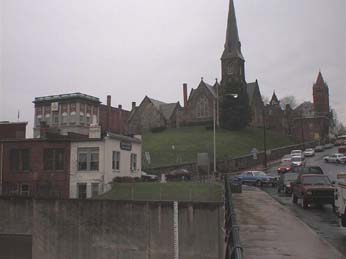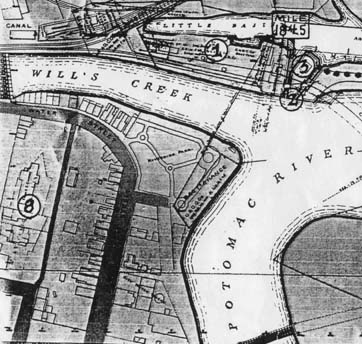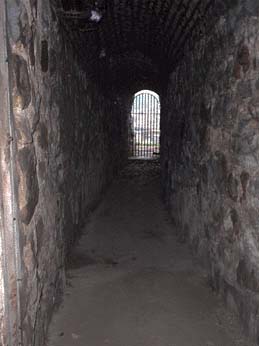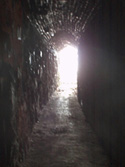Emmanuel Episcopal Church Cumberland, Maryland
By Mr. Vernon Roberts
 Emmanuel Episcopal Church in Cumberland, Maryland sits on a high bluff, commonly referred to as "Fort Hill," overlooking the area where Wills Creek enters the Potomac River. Fort Hill is the site of old Fort Cumberland, which became a crown fort in April 1755. Fort Cumberland provided safety for the settlers on the western boundaries of Maryland and Virginiaduring the French and Indian Wars. Confrontations between the French and the British began in 1754 when the British settlers began to expand into the Ohio Valley, which was already occupied by the French trading with Native Americans. These confrontations escalated until May 18, 1756 when a formal declaration of war was made by the British. This war was called the Seven Years War in Europe and the French and Indian Wars in the Colonies.
Emmanuel Episcopal Church in Cumberland, Maryland sits on a high bluff, commonly referred to as "Fort Hill," overlooking the area where Wills Creek enters the Potomac River. Fort Hill is the site of old Fort Cumberland, which became a crown fort in April 1755. Fort Cumberland provided safety for the settlers on the western boundaries of Maryland and Virginiaduring the French and Indian Wars. Confrontations between the French and the British began in 1754 when the British settlers began to expand into the Ohio Valley, which was already occupied by the French trading with Native Americans. These confrontations escalated until May 18, 1756 when a formal declaration of war was made by the British. This war was called the Seven Years War in Europe and the French and Indian Wars in the Colonies.
 The Potomac River was considered the best route for western trade because it was the only river that cut through the Appalachian Mountains to the Ohio valley. Fort Cumberland was a strategic site until November 28, 1758 when the British captured Fort Duquesne cutting off the French route from Canada to the western areas of Maryland and Virginia. Several tunnels and the powder magazine from the days of Fort Cumberland are still beneath Emmanuel Episcopal. In an attempt to find a route from Washington to the west the Chesapeake and Ohio canal was built. However, as a result of competition from the railroad and other factors the canal never reached Ohio. Its western terminus in Cumberland is a short distance from Emmanuel Church.
The Potomac River was considered the best route for western trade because it was the only river that cut through the Appalachian Mountains to the Ohio valley. Fort Cumberland was a strategic site until November 28, 1758 when the British captured Fort Duquesne cutting off the French route from Canada to the western areas of Maryland and Virginia. Several tunnels and the powder magazine from the days of Fort Cumberland are still beneath Emmanuel Episcopal. In an attempt to find a route from Washington to the west the Chesapeake and Ohio canal was built. However, as a result of competition from the railroad and other factors the canal never reached Ohio. Its western terminus in Cumberland is a short distance from Emmanuel Church.
Cumberland, being the gateway to the west, generated a great deal of traffic. As a result, the canal required a large labor force. However, labor was scarce because the area was predominately rural. Slaves were hired out to the Canal Company to complement the supply of German and Irish indentured servants. Initially slaves were only allowed to work on one side of the canal. Eventually, Maryland passed a law permitting slaves to work on either side of the Potomac River for twelve months. The law specified that a slave not returned to the Virginia side of the Potomac after twelve months should be entitled to freedom.
A Shantytown sprouted up in Cumberland as a result of the influx of workers to the canal. Shantytown was in a part of the city called "Walnut Bottom." This was a great place for the work crews to celebrate during off time. Shantytown consisted of about twenty-five buildings at the river basin. They extended from the B & O underpass to the lower end of Wineow Street and ended near the old Footers Dye works. With its gin joints, bordellos, pool parlors, hotels, warehouses, dry-docks and other hangouts, Shantytown was a great place in which to get lost until the time was right to move to freedom. Shantytown had the reputation of being the roughest, toughest spot along the Canal. There was no segregation in Shantytown, and the workers lived, drank and slept in close proximity to each other. It would be difficult to distinguish a runaway slave from a hired out slave or a free Black in Shantytown.
Local folklore says that many runaway slaves passed through Cumberland in the 1850s, when the Reverend Hillhouse Buell was rector of Emmanuel. Rev. Buell was the second of three brothers who served as rectors of Emmanuel Church. The Buells' were from New York, and were known to be Union sympathizers. During Buell's tenure at Emmanuel, there was a noticeable outreach to African-Americans. There was an increase in the number of African-American slaves as well as freemen listed in the parish records. Hillhouse Buell was an astute politician in his day. He made a deal with a local farmer that helped finance the construction of the church. The present church was completed during his tenure. It seems that a local farmer, Samuel Middleton Semmes, was a Roman Catholic and he wanted his slaves to receive communion.
 However,the pastor of Saint Patrick's Roman Catholic Church, which was less than a mile from Emmanuel, did not believe that Blacks should receive communion. Semmes approached Hillhouse Buell with a pledge of five thousand dollars to the church construction fund, on condition that a balcony be built for the slaves. At that time, five thousand dollars was twenty-five percent of the total construction cost. Buell agreed to add the balcony and to offer the slaves communion. However, as it turned out, the slaves themselves did not wish to receive communion because they had been baptized Roman Catholic and did not wish to receive communion in an Episcopal Church. Semmes himself became a member of the Emmanuel Episcopal Church on
March 3, 1849.
However,the pastor of Saint Patrick's Roman Catholic Church, which was less than a mile from Emmanuel, did not believe that Blacks should receive communion. Semmes approached Hillhouse Buell with a pledge of five thousand dollars to the church construction fund, on condition that a balcony be built for the slaves. At that time, five thousand dollars was twenty-five percent of the total construction cost. Buell agreed to add the balcony and to offer the slaves communion. However, as it turned out, the slaves themselves did not wish to receive communion because they had been baptized Roman Catholic and did not wish to receive communion in an Episcopal Church. Semmes himself became a member of the Emmanuel Episcopal Church on
March 3, 1849.

Local oral history says that runaways would follow the canal to Cumberland. Under the cover of the high brush, they would wait for a signal from the church. The church sexton,
Samuel Demson, a free African-American who had escaped to Maryland from Vicksburg, Mississippi, would ring the church bell twice when the coast was clear. The runaways would come up the hill to a gate, which led into the maze of tunnels under the church. After resting, receiving food and instructions, the runaways were taken through the tunnels that exitedto the other side of the rectory which was across the road. From this point, it was only a five mile walk to the Mason-Dixon Line and freedom.
Top of page
